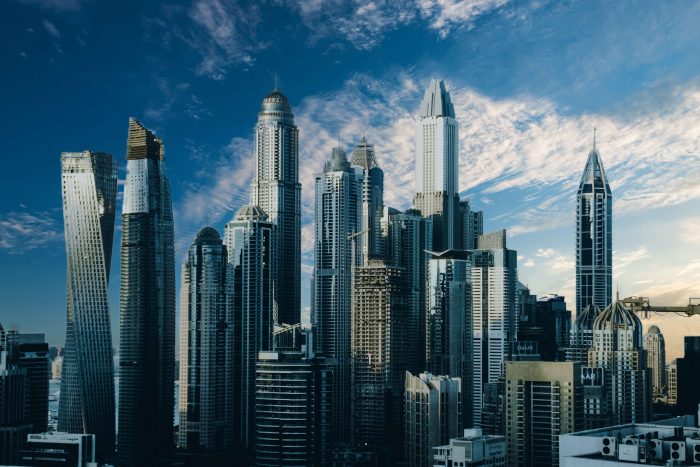Skyscrapers seem to defy gravity, towering hundreds or even thousands of feet into the sky. But have you ever wondered how they don’t collapse under their own weight?
The answer lies in a combination of engineering genius, cutting-edge materials, and physics. From their deep foundations to their flexible structures, skyscrapers are designed to resist gravity, wind forces, and even earthquakes. Let’s break down the science behind these incredible structures!
1. The Forces Acting on a Skyscraper
Every skyscraper must withstand several natural forces that constantly try to bring it down:
🌀 Gravity (Weight of the Building)
- Skyscrapers are massive, weighing hundreds of thousands of tons.
- Engineers design the foundation and core structure to distribute this weight evenly.
💨 Wind Forces (Lateral Load)
- The taller a building is, the more it is affected by wind.
- Some skyscrapers sway several feet at the top but are designed so people inside don’t feel it!
🌍 Earthquake Forces (Seismic Loads)
- In earthquake-prone areas, skyscrapers have shock-absorbing technology.
- Flexible structures bend rather than break during seismic activity.
🌡️ Temperature Expansion & Contraction
- Steel and concrete expand and contract with temperature changes.
- Engineers design joints to allow movement without structural failure.
2. How Skyscrapers Stay Standing
🏗️ a) The Deep Foundation – Anchoring to Bedrock
- Tall buildings need strong foundations that go deep underground.
- There are two main types:
✅ Caisson Foundations – Deep concrete columns drilled into the ground.
✅ Pile Foundations – Long steel or concrete pillars driven deep into the soil. - Example: Burj Khalifa’s foundation goes 164 feet (50 meters) deep!
🏢 b) The Strong Core – The Backbone of a Skyscraper
- Most skyscrapers have a central core made of reinforced concrete and steel.
- This core contains elevators, staircases, and utilities while providing structural stability.
🔗 c) The Steel Skeleton – A Flexible but Strong Frame
- Modern skyscrapers use a steel frame that holds up the building.
- Steel is strong yet flexible, allowing buildings to bend in the wind instead of breaking.
🌬️ d) Wind Resistance – How Skyscrapers “Breathe”
- Architects use aerodynamic designs to reduce wind resistance.
- Some buildings have holes or gaps to allow wind to pass through safely.
- Example: Taipei 101 has a tuned mass damper (a giant pendulum) to reduce swaying!
3. Materials Used in Skyscrapers
To build taller, engineers rely on advanced materials that are strong but lightweight:
🏗️ High-Strength Steel – Can bend without breaking, perfect for skyscrapers.
🏗️ Reinforced Concrete – Used in foundations and cores for strength.
🏗️ Glass & Composite Panels – For energy-efficient facades.
🔬 Fun Fact: The Empire State Building (1931) used over 60,000 tons of steel, while the Burj Khalifa (2010) used modern materials to be twice as tall with half the steel!
4. Smart Technology in Skyscraper Design
🌍 Earthquake-Resistant Technology
- Shock absorbers allow buildings to move with an earthquake instead of resisting it.
- Example: Tokyo Skytree has a flexible center column inspired by ancient pagodas!
💨 Wind-Resistant Innovations
- Tuned mass dampers are massive weights that counteract wind forces.
- Example: Shanghai Tower’s twisted shape reduces wind resistance by 24%!
⚡ Sustainable & Smart Features
- Self-healing concrete repairs cracks on its own.
- Solar panels and wind turbines provide energy.
- Smart glass adjusts its transparency to control sunlight.
5. The Future of Skyscrapers: How Tall Can We Build?
With modern materials and technology, engineers are pushing skyscrapers to new heights:
🚀 The Jeddah Tower (Saudi Arabia) – Set to become the world’s first 1 km-tall skyscraper.
🚀 The X-Seed 4000 (Japan, Concept) – A 4,000-meter-tall mega-skyscraper!
🚀 Space Elevators? – Future concepts explore towers reaching into space!
Conclusion
Skyscrapers are a triumph of human engineering, using deep foundations, strong materials, and flexible designs to withstand gravity, wind, and earthquakes.
From the Burj Khalifa to the Empire State Building, these structures define modern cities and push the limits of architecture.
Next time you see a skyscraper, remember—it’s not just a tall building, it’s a marvel of science and engineering! 🌆🏗️


